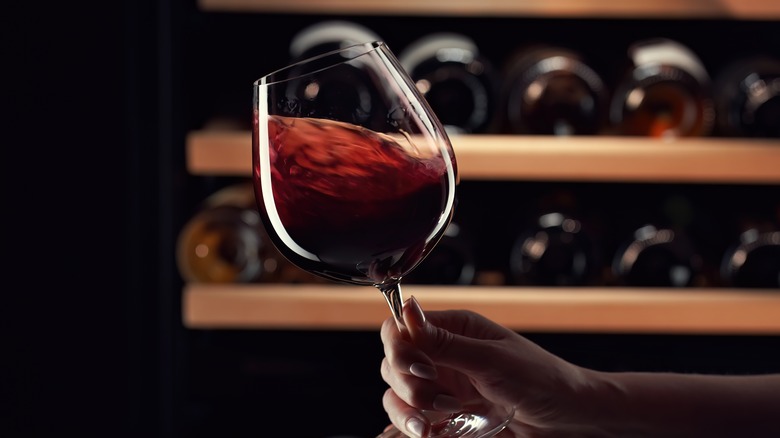Should You Be Holding A Wine Glass By The Stem Or The Bowl?
If you want to consider yourself a wine aficionado, there's more to it than mansplaining why people think they hate chardonnay, or playing the role of the table's guide to natural wines. Knowing your glassware is crucial, whether that means eschewing flutes for Champagne wine glasses, or remembering the correct serving size for a glass of that popular cabernet sauvignon.
Understanding how to properly hold a glass of wine is, obviously, step one. Luckily, Maximilian Riedel, the 11th generation CEO and President of the wine glass company Riedel, offered Food Republic some specifics: "The proper way to hold a stemmed wine glass is to clasp the stem between your thumb, pointer, and middle finger," Riedel explains. "You will then use your ring finger to hold the glass under the base."
This means that even if you were taught to hold your wine glass by the stem, you're probably not holding it far down enough. Instead of clutching the stem for dear life right under the bowl, use the base to your advantage. This style might seem annoying (especially if you've invested in a set of Olivia Pope-esque glasses with stems you could floss with), but getting in the habit will elevate your tasting experience. So what's a little extra effort?
How you hold the glass can change the wine
"It's best to hold the wine by the stem as holding the bowl of the glass can, over time, warm the wine in the glass," Maximilian Riedel explains. This effect is more obvious when it comes to white, sparkling, or rosé wines, as you tend to notice when a wine served cold turns lukewarm. But it's not just about the temperature itself, but how that affects the flavor and texture of the wine.
All wines are meant to be served at specific temperatures, depending on their key characteristics. Whites and rosés, when served chilled, will taste drier and more acidic, but can become sweet and unbalanced if allowed to get lukewarm. Light, fruity red wines that are high in acid often taste better at lower temperatures, and can even be chilled ahead of time to improve their flavor. On the other end, tannic red wines can get away with a little more warmth, which brings out their structure. But while room temperature or chilled red wines are a pleasure, tepid ones can taste harsh and alcoholic. And when it comes to sparkling wines, they will actually lose their effervescence at higher temperatures, and require the cold to better retain the carbon dioxide that gives them their trademark bubbles.
This is why many purists avoid stemless wine glasses, or reserve them solely for red wine. After all, if you've shelled out for a nice bottle, why ruin it with a cheap souvenir from your last bachelorette party?


